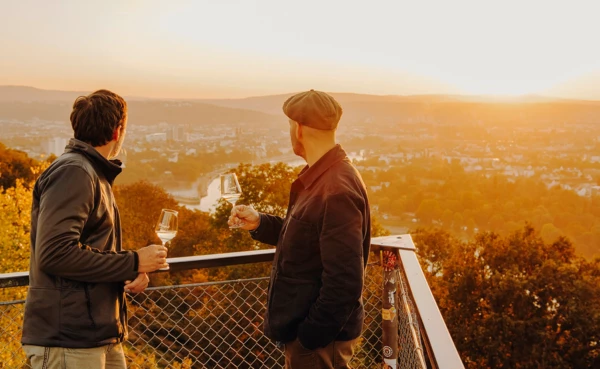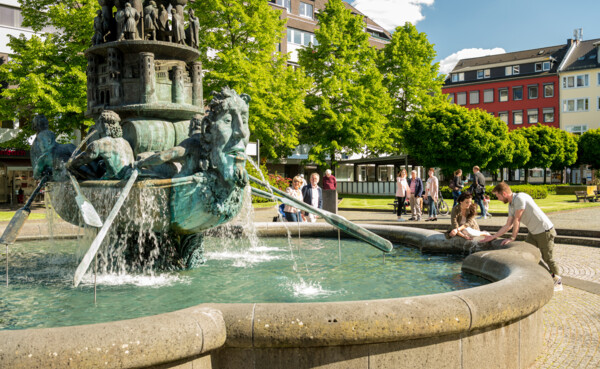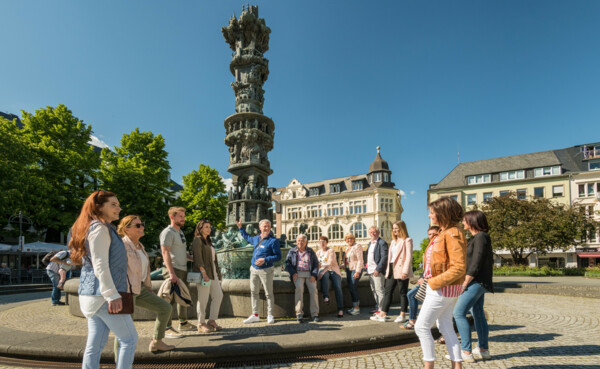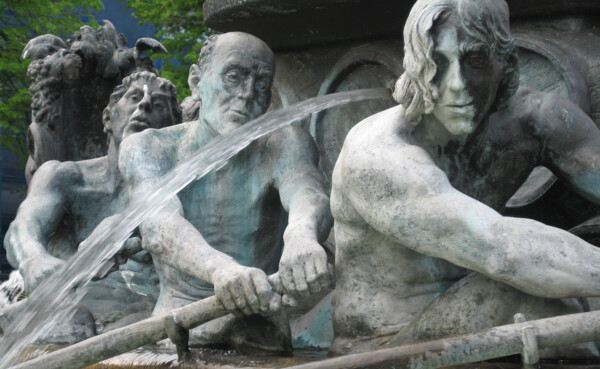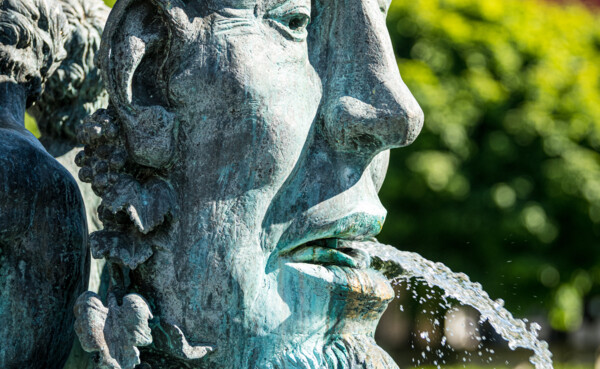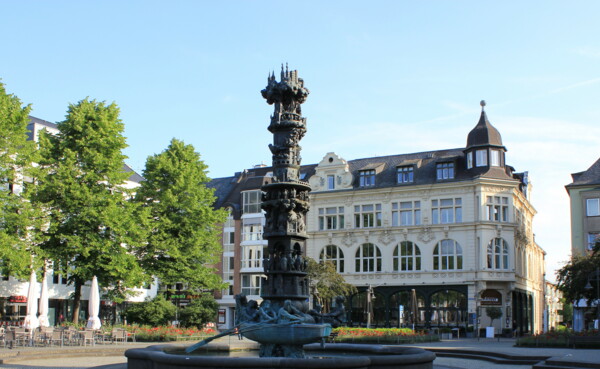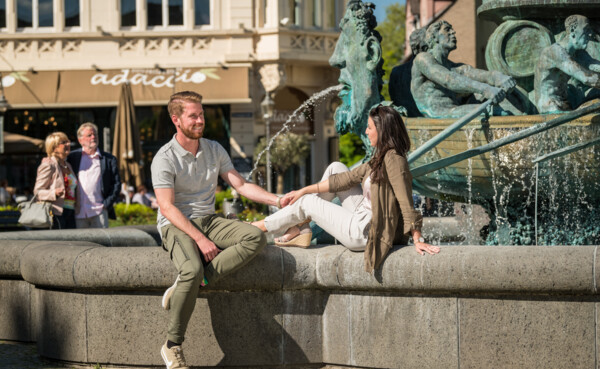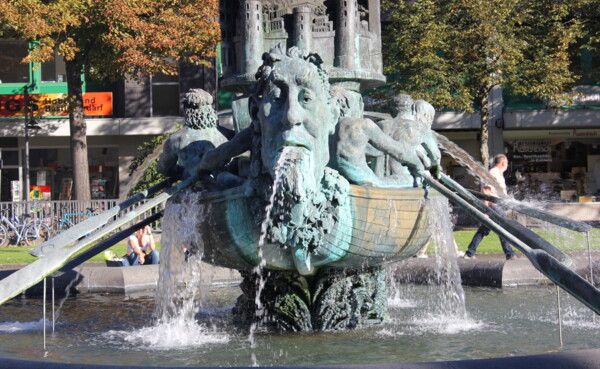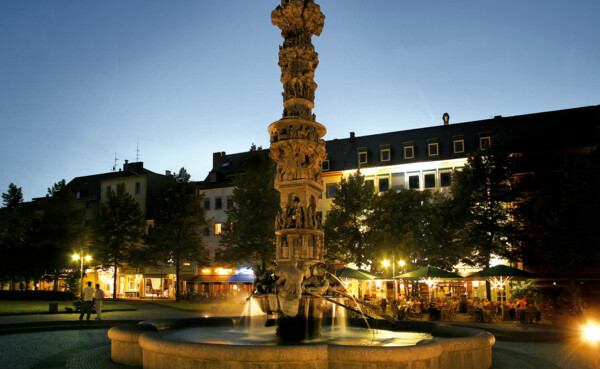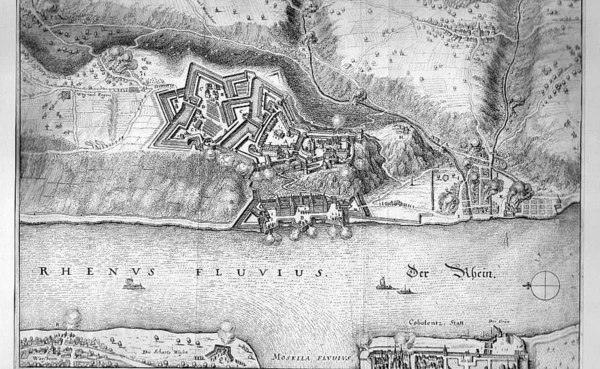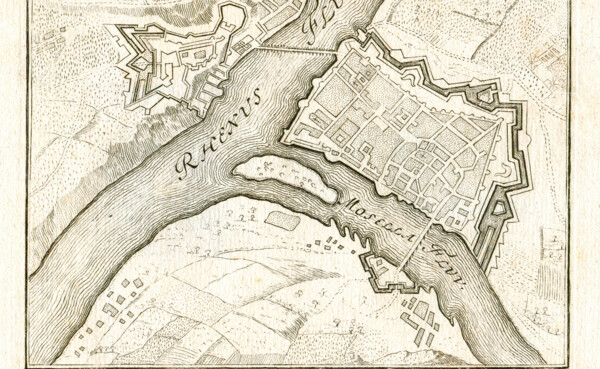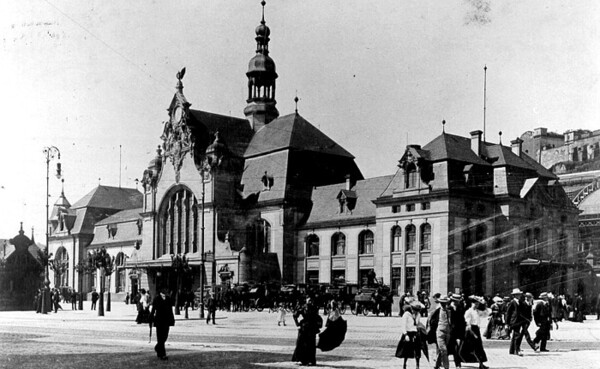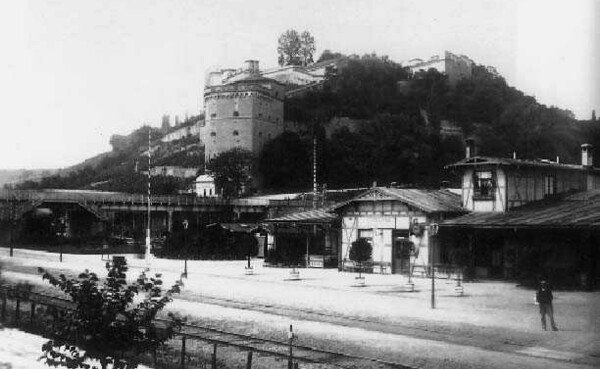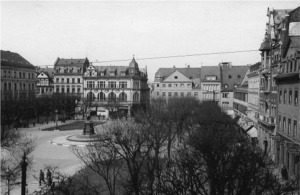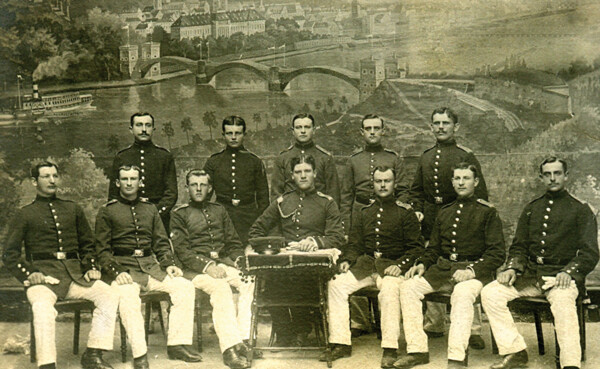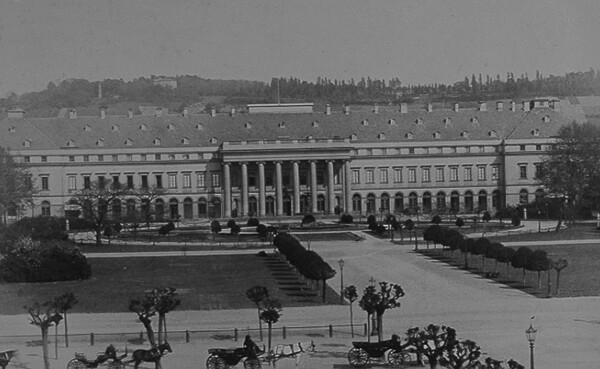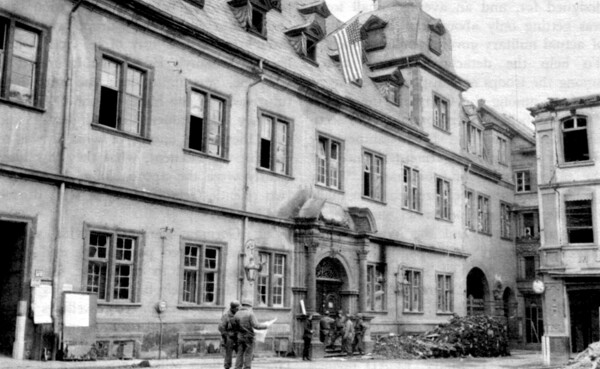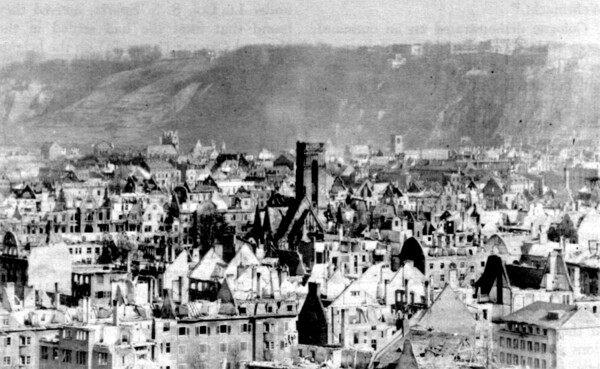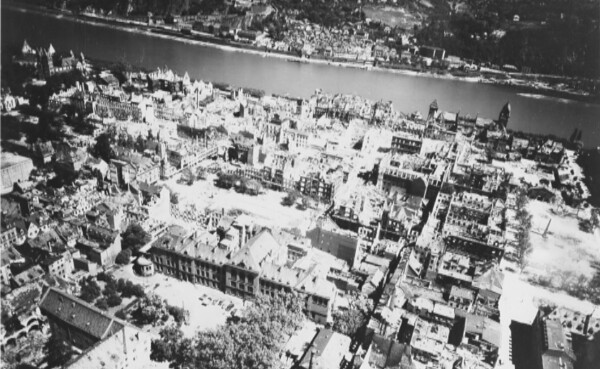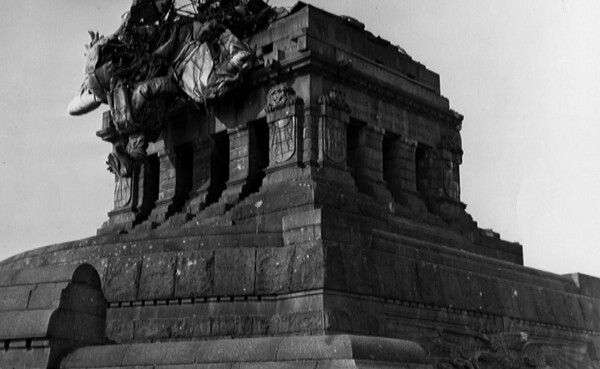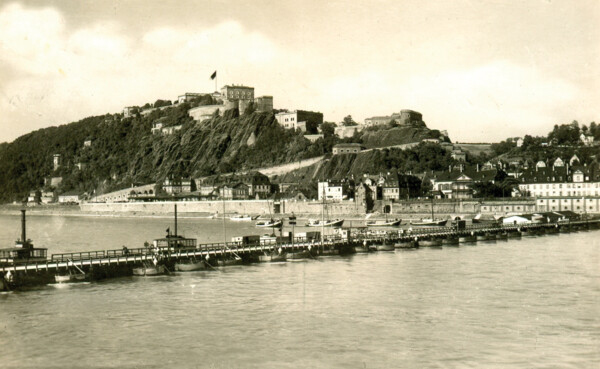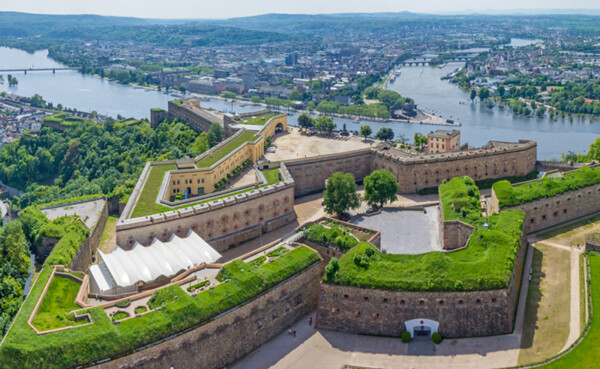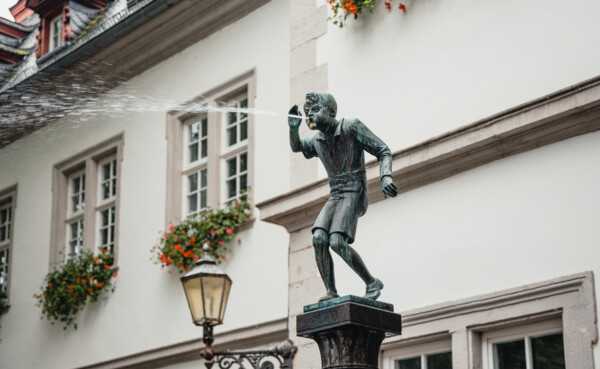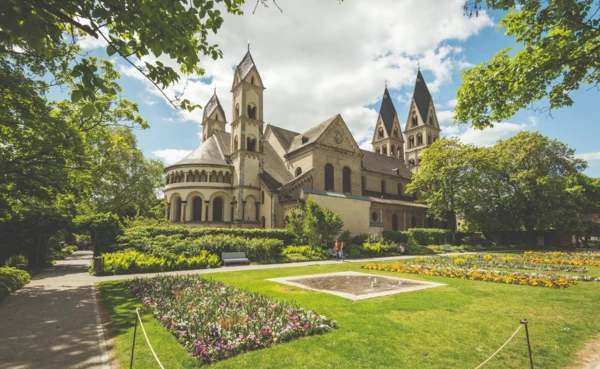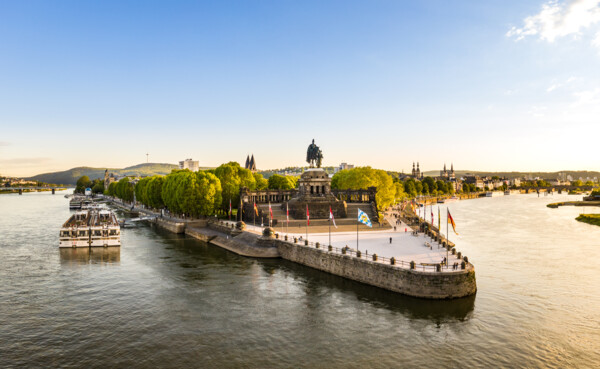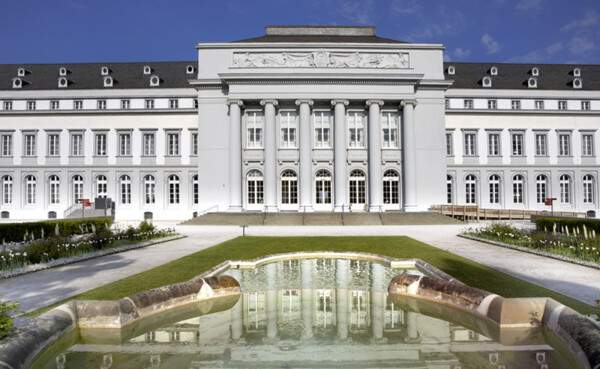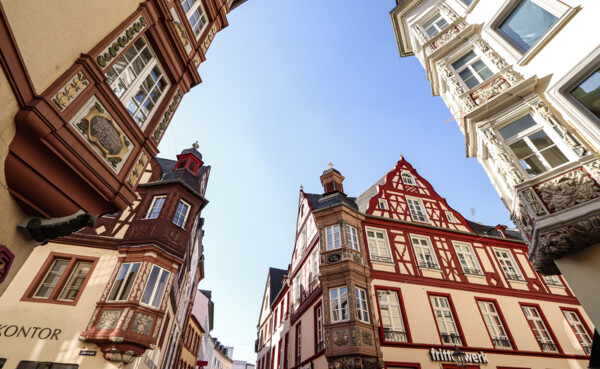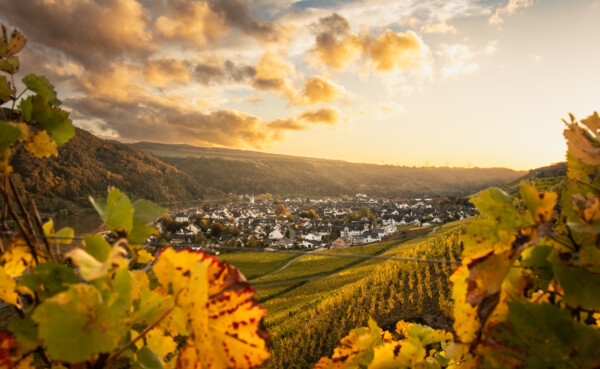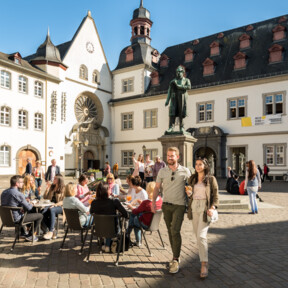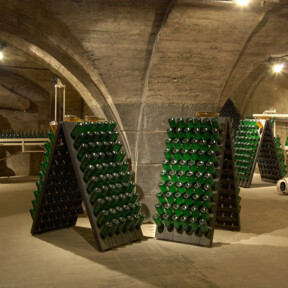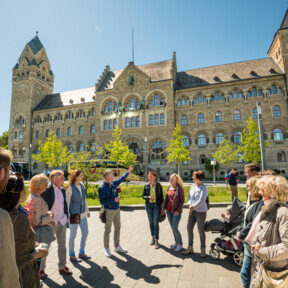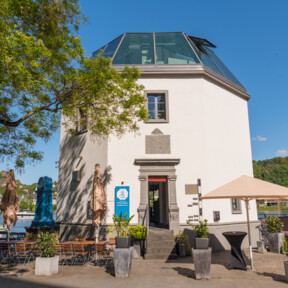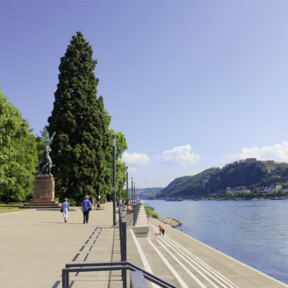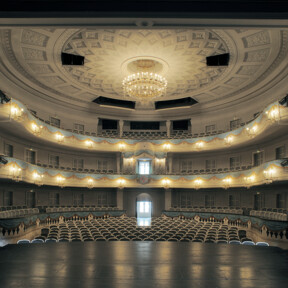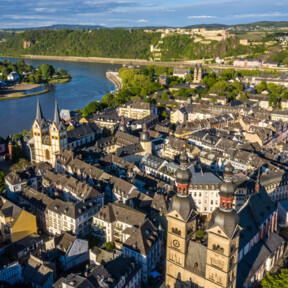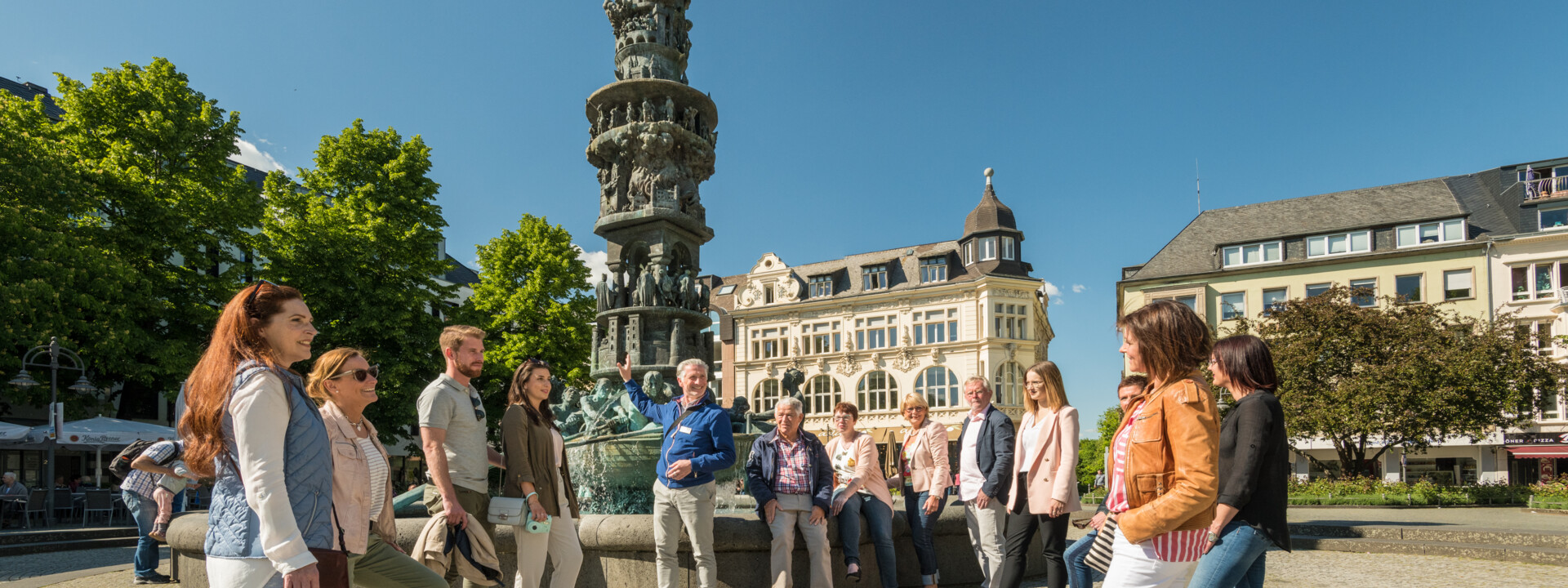
The History Column
The history of Koblenz
Right in the heart of Koblenz's old town, on the lively Görresplatz Square, stands an extraordinary work of art: the History Column.
This fountain, which is around ten metres high, was erected in 1992 to mark the 2000th anniversary of the city of Koblenz and tells the eventful history of the city in an impressive way. In ten detailed scenes, the column leads from the Roman foundation through the Middle Ages, the Electorate and the French occupation to the present day. Created by artist Jürgen Weber, the history column is not only a work of art, but also a tangible history book; a place where the past comes to life.
1st-5th century
Roman Fort Settlement
The history of Koblenz begins with the Roman expansion under Julius Caesar around 55 BC, when the area at the confluence of the Rhine and Moselle rivers became part of the Roman Empire. The Romans built a fortified fort called castellum apud confluentes ("fort at the confluence") on land previously inhabited by Celts. This name is considered to be the origin of today's city name Koblenz.
For around 500 years, the Romans influenced the region through military, trade and infrastructure. A so-called vicus was built next to the fort, where traders, craftsmen and members of the soldiers' families lived. Koblenz developed into a lively town with markets, bathing facilities, workshops and taverns. The Romans brought a wealth of knowledge with them—from road construction to heating technology and viticulture.
For around 500 years, the Romans influenced the region through military, trade and infrastructure. A so-called vicus was built next to the fort, where traders, craftsmen and members of the soldiers' families lived. Koblenz developed into a lively town with markets, bathing facilities, workshops and taverns. The Romans brought a wealth of knowledge with them—from road construction to heating technology and viticulture.
6th-9th century
Crown Estate and Conference Venue
After the retreat of the Romans around 470 AD, the Franks took control of the Koblenz region. Due to its strategically favorable location, the town developed into an important centre for political meetings.
In 842, negotiations between Charlemagne's grandsons took place in the St. Castor Basilica, resulting in the Treaty of Verdun in 843. This marked the creation of the kingdoms of France, Germany and the Middle Kingdom of "Lotharingia", to which Koblenz also belonged.
Under Frankish rule, the town became a royal palace and a spiritual centre. The St. Castor Basilica gained great importance as a church and burial site in the 9th century. Monks shaped religious life and new settlement structures emerged around the former fort. Koblenz continued to develop into an administrative and meeting place with close links to the later archbishopric of Trier.
In 842, negotiations between Charlemagne's grandsons took place in the St. Castor Basilica, resulting in the Treaty of Verdun in 843. This marked the creation of the kingdoms of France, Germany and the Middle Kingdom of "Lotharingia", to which Koblenz also belonged.
Under Frankish rule, the town became a royal palace and a spiritual centre. The St. Castor Basilica gained great importance as a church and burial site in the 9th century. Monks shaped religious life and new settlement structures emerged around the former fort. Koblenz continued to develop into an administrative and meeting place with close links to the later archbishopric of Trier.
10th-12th century
From the Frankish Empire to the Electorate of Trier
After the Frankish conquest, Koblenz was a royal "crown estate". In 1018, Emperor Henry II transferred the city to the Archbishop of Trier in order to strengthen his influence on the Rhine. This marked the beginning of around 750 years of belonging to the archbishopric and later electorate of Trier; a time of intense religious, cultural and political influence.
Under the rule of the archbishops of Trier, Koblenz became a residential city with secular and spiritual significance. This was evident in prestigious buildings such as the Liebfrauenkirche and the Florinskirch district. Monasteries, convents and religious houses dominated the cityscape. At the same time, a centre of trade and crafts emerged with the first urban structures and markets; long before the official granting of city rights.
Under the rule of the archbishops of Trier, Koblenz became a residential city with secular and spiritual significance. This was evident in prestigious buildings such as the Liebfrauenkirche and the Florinskirch district. Monasteries, convents and religious houses dominated the cityscape. At the same time, a centre of trade and crafts emerged with the first urban structures and markets; long before the official granting of city rights.
12th-13th century
Crusades and Slave Trade
Although Koblenz was not directly involved in the Crusades, it was part of a Europe-wide network that was influenced by them. The city's oldest known customs list from 1209, which even mentions taxes on slaves, presumably spoils of war, is evidence of this period.
In the High Middle Ages, Koblenz was located on one of the most important trade routes in Europe: the Rhine. Goods, pilgrims and crusaders passed through the town, monasteries and hospitals offered them accommodation and local markets profited from the increasing traffic. Religious movements such as mendicant orders and streams of pilgrims shaped the cityscape and spiritual life. Koblenz was not a starting point for crusades, but a reflection of the dynamic era of the 12th and 13th centuries.
In the High Middle Ages, Koblenz was located on one of the most important trade routes in Europe: the Rhine. Goods, pilgrims and crusaders passed through the town, monasteries and hospitals offered them accommodation and local markets profited from the increasing traffic. Religious movements such as mendicant orders and streams of pilgrims shaped the cityscape and spiritual life. Koblenz was not a starting point for crusades, but a reflection of the dynamic era of the 12th and 13th centuries.
13th-16th century
A Thriving Urban Community
Between the 13th and 16th centuries, Koblenz developed into a prosperous town with lively craft and commercial activity. Monasteries, convents and the administration of the Electorate of Trier dominated public life. Evidence of this era can still be seen today, such as medieval churches, the Old Castle on the banks of the Moselle and the Moselle bridge built by Elector Balduin of Luxembourg (1307-1354).
The economic boom also increased the self-confidence of the citizens. Guilds emerged and demands for co-determination increased; sometimes in conflict with the electoral rule. New quarters were built, markets flourished and the city walls were extended. The Gothic style shaped the city's appearance, accompanied by new religious trends and monastic education. Koblenz became a centre of medieval trade and cultural life.
The economic boom also increased the self-confidence of the citizens. Guilds emerged and demands for co-determination increased; sometimes in conflict with the electoral rule. New quarters were built, markets flourished and the city walls were extended. The Gothic style shaped the city's appearance, accompanied by new religious trends and monastic education. Koblenz became a centre of medieval trade and cultural life.
17th-18th century
Thirty Years' War & The Witch Craze
Koblenz was hard-fought during the Thirty Years' War. French and imperial troops fought heavy battles around the city. Barely recovered, Koblenz again suffered great destruction from heavy French fire during the War of the Palatinate Succession, although there was no direct conquest.
During this time, religious fear, social tensions, famine and disease prevailed. Under the influence of the Counter-Reformation, there were numerous witch trials, which mainly affected women. The belief in witchcraft, combined with political interests, led to persecution and violence—a dark chapter in the city's history with far-reaching social consequences.
During this time, religious fear, social tensions, famine and disease prevailed. Under the influence of the Counter-Reformation, there were numerous witch trials, which mainly affected women. The belief in witchcraft, combined with political interests, led to persecution and violence—a dark chapter in the city's history with far-reaching social consequences.
around 1800
The French Revolution
With the construction of the Electoral Palace, Koblenz became a royal seat. However, the upheavals of the French Revolution soon reached the region. In 1791/92, numerous fugitive nobles from France sought refuge in the city, which was therefore regarded as "Little Paris". In 1794, French troops occupied Koblenz, which was annexed shortly afterwards and became the capital of the Rhine-Moselle department in 1798.
The incorporation into French territory was followed by far-reaching changes: French law, modern administration and the metric system were introduced. Secularization led to the dissolution of ecclesiastical institutions and the nationalisation of their property. While many citizens benefited from new freedoms and economic opportunities, others lost ancestral rights. French rule brought political change and shaped the cityscape into the modern era.
The incorporation into French territory was followed by far-reaching changes: French law, modern administration and the metric system were introduced. Secularization led to the dissolution of ecclesiastical institutions and the nationalisation of their property. While many citizens benefited from new freedoms and economic opportunities, others lost ancestral rights. French rule brought political change and shaped the cityscape into the modern era.
19th-20th century
The Prussian Era
The Prince von Metternich, a statesman from Koblenz, played a central role in the reorganization of Europe after the Napoleonic Wars. At the Congress of Vienna in 1815, the Rhineland was awarded to Prussia, whereupon Koblenz became the seat of the Chief President of the Rhine Province. From 1817, the Ehrenbreitstein fortress was built, one of the strongest fortifications in the western empire.
Under Prussian administration, Koblenz developed into a modern administrative centre. New authorities, schools and courts were established and the cityscape was characterized by neoclassical buildings. The Rhine was made more accessible with locks, bridges and ports, which promoted trade and traffic. The military shaped public life, while Prussian discipline met the Rhineland way of life. Koblenz became an important link between West Germany and Berlin.
Under Prussian administration, Koblenz developed into a modern administrative centre. New authorities, schools and courts were established and the cityscape was characterized by neoclassical buildings. The Rhine was made more accessible with locks, bridges and ports, which promoted trade and traffic. The military shaped public life, while Prussian discipline met the Rhineland way of life. Koblenz became an important link between West Germany and Berlin.
World War II
Destruction 1944
During the Second World War, 87 percent of Koblenz was destroyed by fire and explosive bombs and was occupied by American troops in March 1945. As of July, the city belonged to the French occupation zone. At the end of the war, Koblenz lay in ruins; housing and food were in short supply.
Despite the difficult situation, reconstruction began quickly. Public life was reorganised with great energy. A special sign of the democratic awakening was set by the Consultative State Assembly, which convened in the municipal theatre on November 22, 1946. The constitution for the new federal state of Rhineland-Palatinate was prepared there. Koblenz was its first state capital until 1951—an important chapter in the political reorganization of post-war Germany.
Despite the difficult situation, reconstruction began quickly. Public life was reorganised with great energy. A special sign of the democratic awakening was set by the Consultative State Assembly, which convened in the municipal theatre on November 22, 1946. The constitution for the new federal state of Rhineland-Palatinate was prepared there. Koblenz was its first state capital until 1951—an important chapter in the political reorganization of post-war Germany.
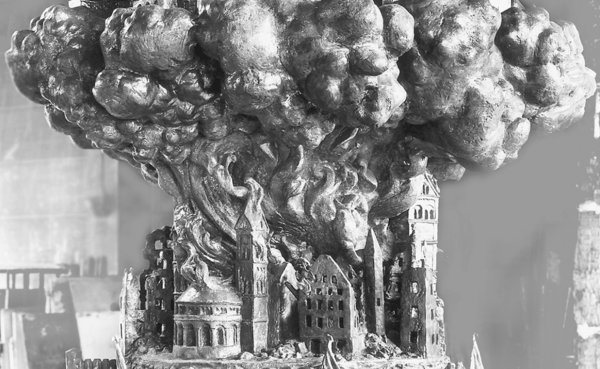
Today (until 1992)
A Future-Oriented City
With the Rittersturz Conference in 1948, Koblenz made an important contribution to the German post-war order—a milestone on the way to the Basic Law. In the decades that followed, the city developed into the largest garrison town in western Germany.
Today, Koblenz is an important business and administrative location with a wide range of educational opportunities. As a modern university city, it attracts young people from all over the world. Investments in sustainable mobility, digitalisation and the preservation of its cultural heritage strengthen its future viability. Its location on the Rhine and Moselle, green open spaces and an active city life offer the residents of Koblenz a high quality of life.
Today, Koblenz is an important business and administrative location with a wide range of educational opportunities. As a modern university city, it attracts young people from all over the world. Investments in sustainable mobility, digitalisation and the preservation of its cultural heritage strengthen its future viability. Its location on the Rhine and Moselle, green open spaces and an active city life offer the residents of Koblenz a high quality of life.
Then to Now
2002
City of Koblenz becomes part of the UNESCO World Heritage Site "Upper Middle Rhine Valley"
The Upper Middle Rhine Valley between Bingen/Rüdesheim and Koblenz has been a UNESCO World Heritage Site since 2002. The award recognises the unique combination of nature, culture and history: mighty castles, steep vineyards and centuries-old towns characterise the landscape along the "Romantic Rhine".
In Koblenz, the Deutsches Eck, Ehrenbreitstein Fortress, the historic old town and the cable car across the Rhine are part of the protected cultural landscape. Recognition by UNESCO is not only an honour, but also a mission to preserve this special heritage for future generations.
In Koblenz, the Deutsches Eck, Ehrenbreitstein Fortress, the historic old town and the cable car across the Rhine are part of the protected cultural landscape. Recognition by UNESCO is not only an honour, but also a mission to preserve this special heritage for future generations.

2011
BUGA in Koblenz
The 2011 Federal Horticultural Show was a turning point for Koblenz. It saw central areas of the city redesigned, including the Deutsches Eck, the Electoral Palace and the plateau of Ehrenbreitstein Fortress. One highlight: the opening of the cable car across the Rhine, which has since connected the city centre with the fortress—handicap accessible, sustainable and with a unique view. At the same time, Ehrenbreitstein Fortress was developed into the cultural heart of the region. Today, it is a lively venue for exhibitions, concerts and events as well as a symbol of Koblenz's successful transformation into a modern cultural city on the Rhine.
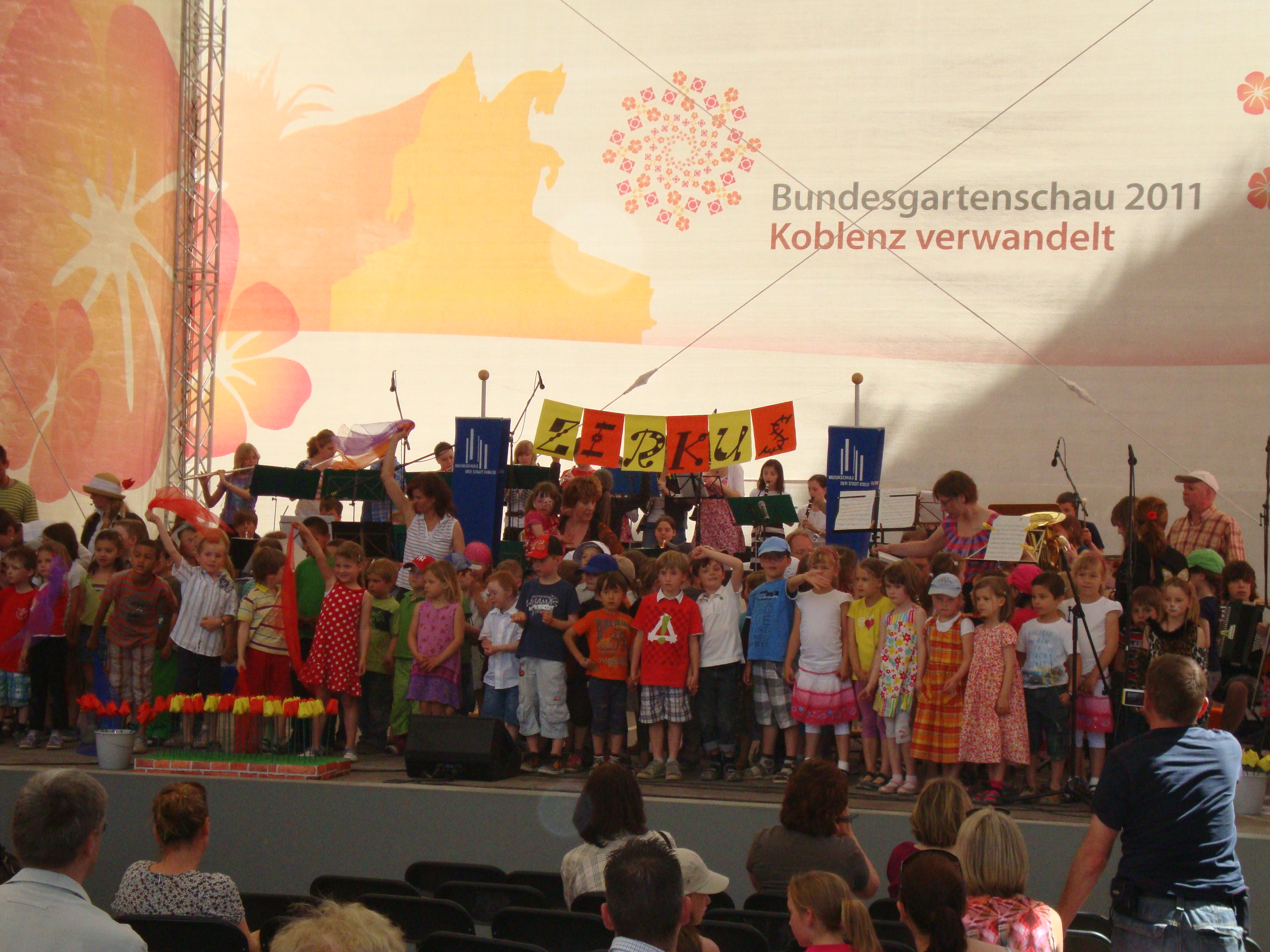
2013
Redesign of the Central Square and Opening of the Forum Confluentes
With the redesign of the central square, Koblenz has gained a modern, urban centre. The centerpiece is the Forum Confluentes, an architecturally striking building and lively place for culture, education and encounters. Three important institutions have found a new home here: the Middle Rhine Museum with its impressive art collection, Koblenz Tourist Information as the first port of call for visitors to the city and the Koblenz City Library, which combines modern knowledge and digital work. In keeping with its name, which stands for the confluence of ideas, cultures and living environments, the Forum Confluentes brings people together.
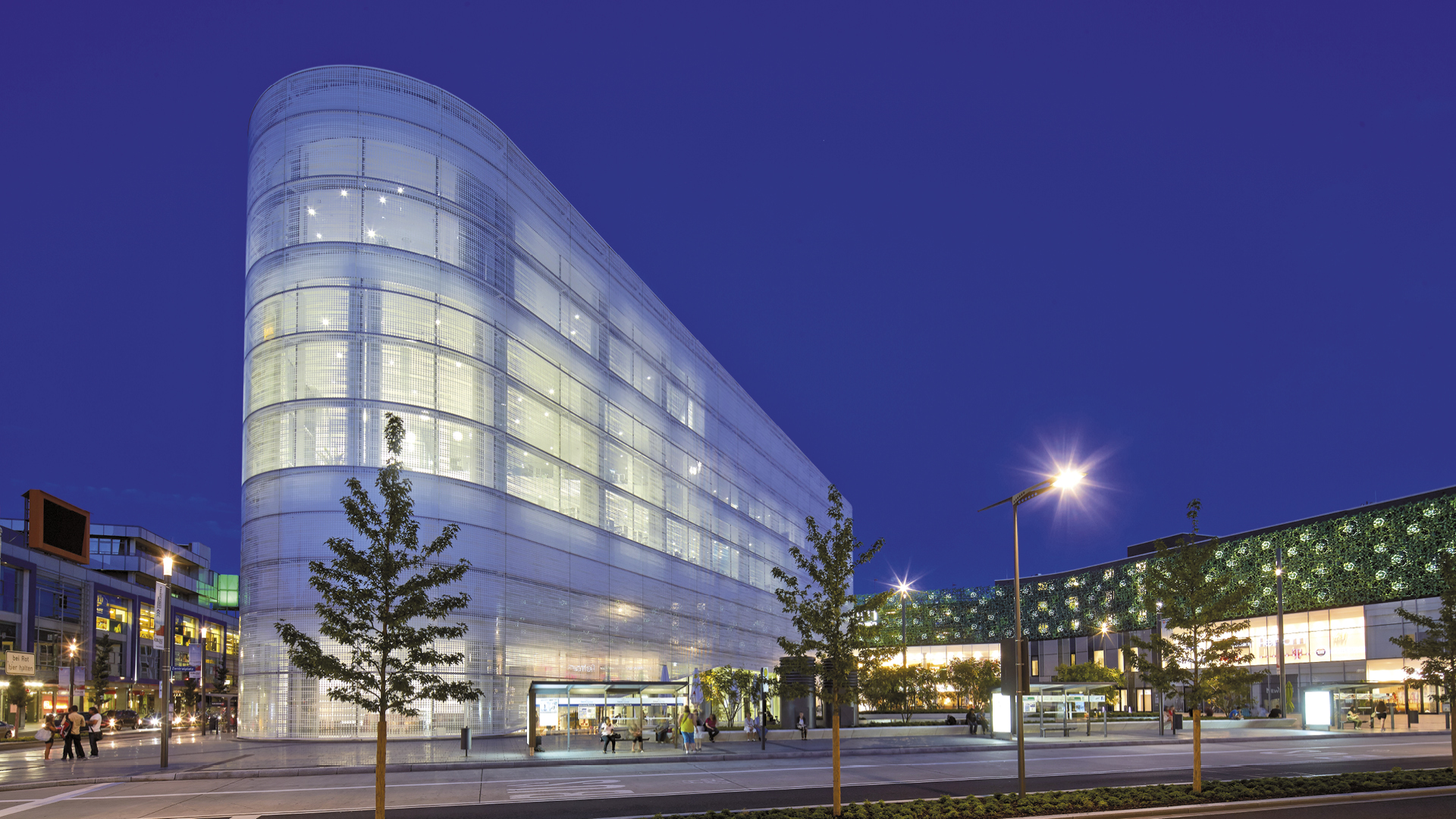
2017
Koblenz Celebrates 200 Years as a "Fortress City"
Koblenz looks back on an eventful fortress history and celebrated a special anniversary in 2015: 200 years as a fortress city. The city paid tribute to its role as a strategic location and military centre since Prussian times. Numerous events, exhibitions and guided tours brought the history of the Prussian fortifications to life; above all at Ehrenbreitstein Fortress, which is still one of the largest preserved fortresses in Europe. The anniversary brought the fortress into focus not only as a historical monument, but also as a living place of culture, increasing awareness of the city's architectural heritage.
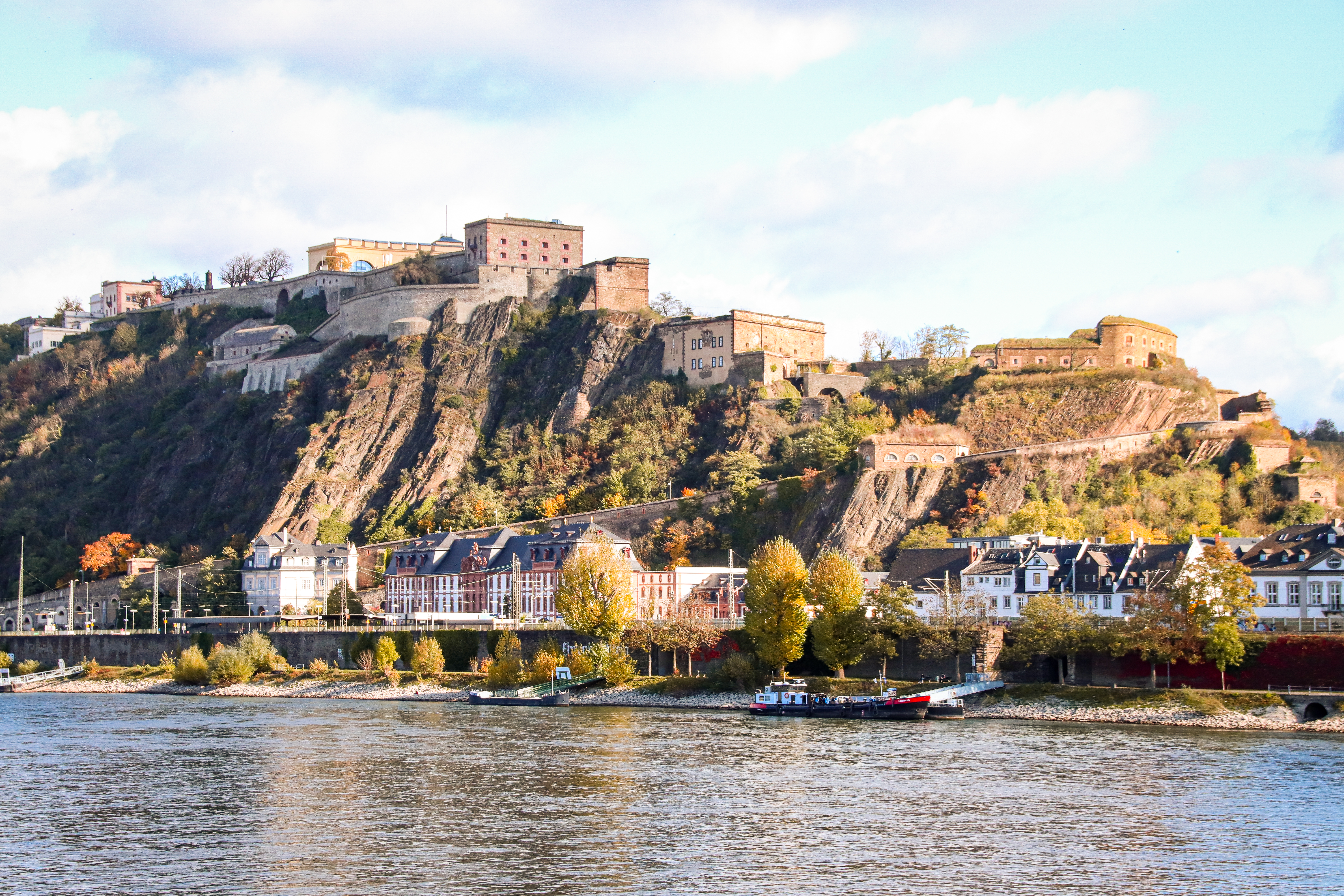
2021
Koblenz Establishes Itself as the "Wine City of Koblenz"
In recent years Koblenz has successfully established itself as a wine city right in the heart of two renowned wine-growing regions: The Moselle and Middle Rhine valleys. With wine festivals, wine shops, wine walks and numerous events centred around regional wine, Koblenz has established itself as a place of enjoyment and hospitality. The city brings together vintners, guests and locals celebrating wine as a living part of its identity. Whether at the Deutsches Eck with a view of the Rhine or in the historic alleyways of the old town, wine culture is simply part of Koblenz.

The Artist
1928-2007
Jürgen Weber
Jürgen Weber (1928-2007) was an important German sculptor. After studying medicine, art history and sculpture, he became a professor at the TH Braunschweig in 1960. His work includes numerous well-known sculptures and fountains, including the portal of the Jacobi Church in Hamburg, the "Marriage Carousel" in Nuremberg and the "Ship of Fools" in Hamelin.
Weber's figurative style is characterized by expressive drama, socially critical symbolism and often ironic refraction. He frequently explored themes such as power, religion, love and death.
The history column in Koblenz, a gift from the state of Rhineland-Palatinate to mark the city's 2000th anniversary, was designed by Weber and completed in 2000. It is one of his most important works in public space. In ten superimposed pictorial zones, it tells the story of the city from Roman times to the 20th century: multi-layered, satirical and visually powerful.
As with his other large sculptures, Weber worked with the Noack art foundry in Berlin. He was a member of the Berlin Academy of Arts, received several awards and taught at the TH Braunschweig until his death. His estate is now partly managed at the TU Braunschweig.
Weber's figurative style is characterized by expressive drama, socially critical symbolism and often ironic refraction. He frequently explored themes such as power, religion, love and death.
The history column in Koblenz, a gift from the state of Rhineland-Palatinate to mark the city's 2000th anniversary, was designed by Weber and completed in 2000. It is one of his most important works in public space. In ten superimposed pictorial zones, it tells the story of the city from Roman times to the 20th century: multi-layered, satirical and visually powerful.
As with his other large sculptures, Weber worked with the Noack art foundry in Berlin. He was a member of the Berlin Academy of Arts, received several awards and taught at the TH Braunschweig until his death. His estate is now partly managed at the TU Braunschweig.
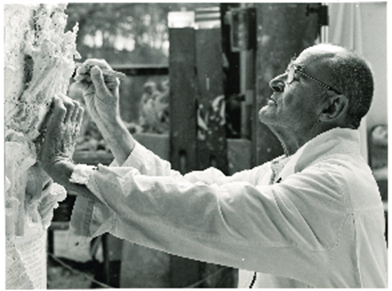
Points of Interest near the History Column
Experience Koblenz
Koblenz is a city that can be enjoyed by everyone. Whether you're looking for active adventures or a relaxed holiday, you're in the right place. We have curated a number of experiences for every type of traveler.
View the experiences
